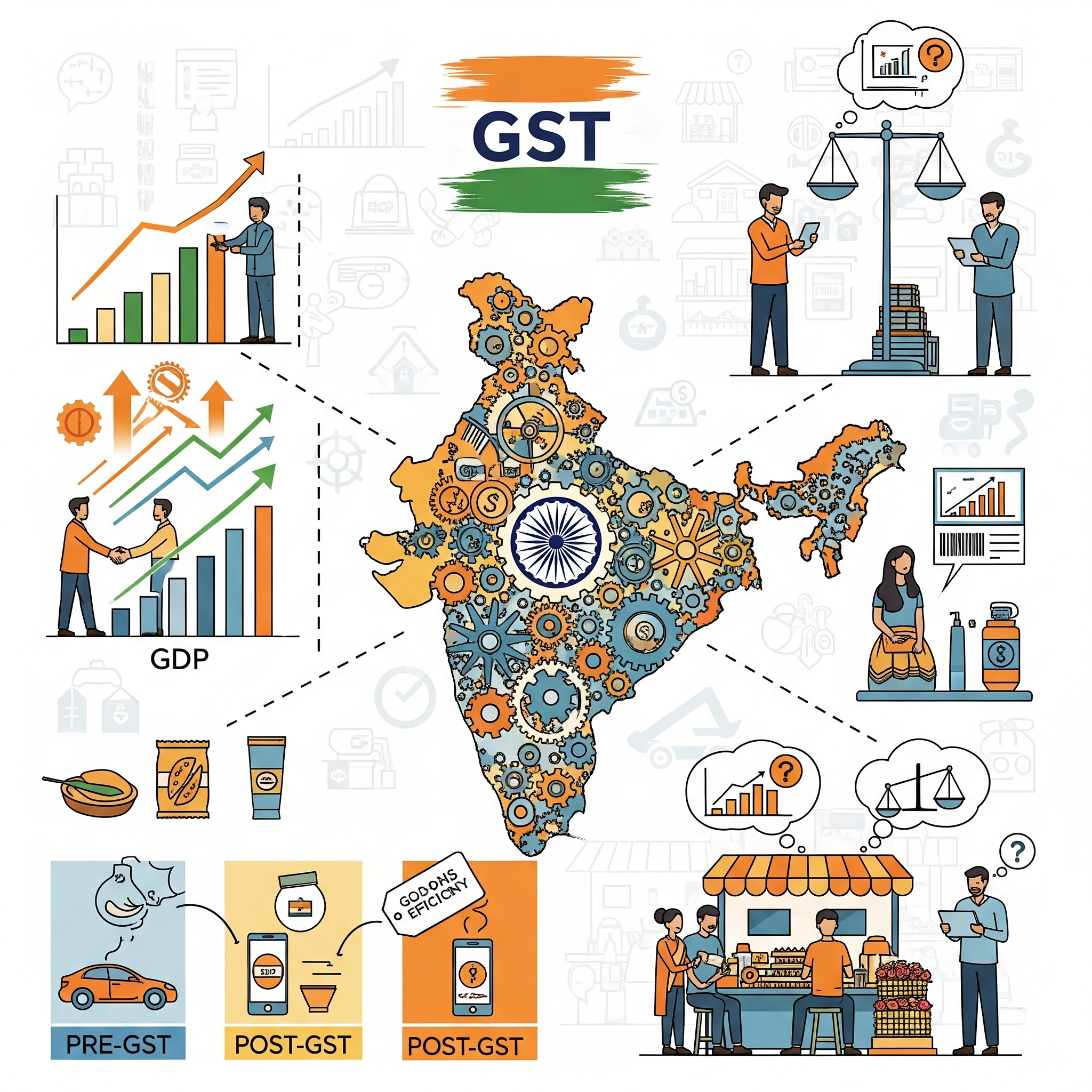GST 2.0: India’s Big Tax Overhaul and What It Means for You
The Indian economy is going to see one of the largest indirect tax reforms since the launch of the Goods and Services Tax (GST) in 2017. Through the meeting of the 56th GST Council, the government has proposed a rationalization of the tax slab – some experts are saying GST 2.0. This decision is set to influence millions of homes, small businesses and large industries across the country.
According to reports, the government is planning to merge the existing four-level GST system into a simple structure. Instead of 5%, 12%, 18%and 28%slabs, India may soon have only two main slabs: 5%and 18%, a special 40%”sin and luxury” tax on items such as tobacco, alcohol and luxury cars.
This step is being observed by economists and industry leaders as a step that will simplify compliance, reduce the consumer’s burden, and potentially promote economic growth. But what does it mean for you and your everyday expenses?
Let’s break it. Why is the government cutting the GST rates?
Since its introduction, GST has gone through several rounds and modifications. However, critics often reported that the structure was very complex, in which many slabs were leading to confusion and controversies.
The latest effort of the government – which is generally referred to as GST 2.0 India – its objective is: To simplify the tax structure so that it is easy to understand both consumers and businesses.
Reduce the prices of necessary commodities and services to provide relief to middle class families. Promoting consumption, especially beyond the festive season. Assistant industries such as FMCG, electronics and automobiles are asking for rational rates.
With Diwali 2025 around the corner, the decrease in this GST is also expected to be a time to encourage consumer expenses.
What is becoming cheaper under the new GST rates?
The most exciting part of this improvement is the list of expected products to see low taxes. According to several reports, about 175 items can be cheap.
Essential every day
- Toothpaste, shampoo, talcum powder, soap – GST can fall from 18% to 5%.
- Cooking oils, sugar, noodles, milk powder, chocolate – transfer from 12% to 5%.
This means that after implementing new rates, your monthly grocery bill can be reduced significantly.
Consumer Durables
- Air Conditioner (ACS), TV, refrigerator, washing machine – Tax reduced by 28%.
- Hybrid car and motorcycle – expected to go up to 18%from the highest slab.
This will make large-ticket purchases more affordable for homes and encourage high sales in electronics and automobile industries.
Festive Season Boost
With the hope of rolling out by Diwali 2025, consumers will be likely to enjoy low prices on both the necessary and luxury purchases during India’s largest purchasing season.
Impact of GST 2.0 on Consumers
For the average Indian household, this GST reduction translates to direct savings. There are essential daily use items such as toothpaste and shampoo. The decline of 18% to 5% GST can make them 10–15% cheaper. Similarly, families planning to buy a new AC or TV will now pay much less.
Apart from saving money, consumers will also benefit from clear pricing structures. The simplified GST system means low confusion and less controversy over taxation.
Impact on Businesses
Business is also the main winner in this reform. This way:
- FMCG companies: With low GST on shampoos, toothpastes, chocolate and noodles, these brands expect an increase in demand.
- Electronics & Appliance makers: Low rate will encourage customers to upgrade equipment.
- Auto industry: GST cut on hybrid cars and motorcycles can stimulate sales in an area that is under pressure.
- Compliance relief: GST 2.0 also promises to reduce auto returns, pre-refunds and rapid refunds, paperwork and compliance costs.
Small and medium enterprises (SMEs), which often struggle with complex filing requirements, will be highly benefited from this simplified structure.
What is the “Sin and Luxury” Tax?
The GST Council has also proposed 40% tax on sin and luxury goods. It also includes:
- Tobacco and related products
- Alcohol
- High-end luxury cars
- Possibly some luxury services
This step ensures that common families get relief, the government still maintains a strong revenue stream from luxury and harmful products.
State vs Centre: Revenue Implications
While consumers and businesses celebrate tax deduction, some states have expressed concern about revenue deficit. To balance it, the center can be:
- Provide compensation packages to states in the initial years. .
- Increase collection efficiency through tech-managed GST compliance.
- Extend the tax base by bringing more businesses under GST.
Experts believe that if well applied, increasing consumption from cheap goods will offset the possible revenue dip.
Timeline for Implementation
According to Reuters and IndiaTimes, the GST Council aims to implement these changes by Diwali 2025.
This time is strategic: the sale of the festive will be promoted, consumers will welcome savings, and industries will benefit from increased demand.
Long-Term Benefits of GST 2.0
- Higher Consumption: Low prices → high demand → strong economy.
- Ease of Doing Business: Low slabs and compliance simplification make life easier for entrepreneurs.
- Global Competitiveness: You can make India a strong player in global trade by reducing electronics, FMCG and automobiles.
- Middle-Class Relief: The burden by reducing the burden puts more money in the hands of common citizens.
The upcoming GST rationalization 2025 is more than only one tax improvement – it is a reset of how India manages indirect taxation. By cutting GST rates on essential commodities, consumer durables and automobiles, the government is directly targeting strength and development. At the same time, simplifying compliance will reduce stress on businesses and will promote economic efficiency.
As Diwali 2025, Indian families are designed for the most profit. Whether it is cheap grocery items, the cost of equipment low, or better pricing on cars, the average consumer will feel the positive impact of GST 2.0 India.
For businesses, this is a golden opportunity to tap in the demand for celebration and long -term development. And for policy makers, this improvement indicates a step towards a simple, fair and more efficient tax system.
One thing is certain: GST 2.0 will be a decisive moment in India’s economic journey.





